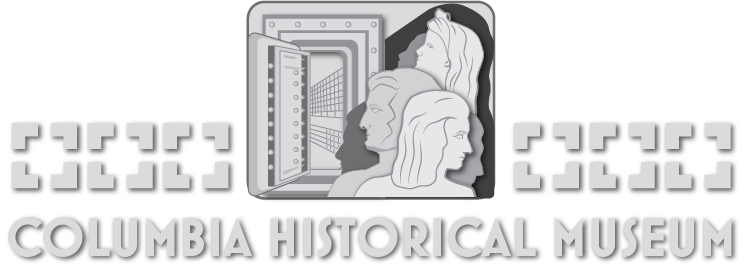![]()
By Winston C. Avera Jr.
Apparently another location to build a new church had been considered since there is a deed from Anna L. Sharp to the trustees of the Methodist Episcopal Church of Columbia, conveying lots in Block 15 in Columbia for the purpose of divine worship (November 15, 1884). There is no indication that this property was ever used for a church building.
A letter dated May 24, l851, written from Brazoria by Francis Richardson Singleton to his sister, tells of his conversion at a church 15 miles from home. “We are now in the Methodist Church and the happiest people almost imaginable.” Singleton’s descendant who owned the letter said that he assumes that this was the Columbia Methodist Church.
In 1866, Columbia Methodist Church was recorded as having 70 white members. One of the members of this early church was Carry Nation who joined with her husband David in 1877. Many of the early church records between 1850-1890 were destroyed in a storm, but Rev. Ira. M. Bryce revised some of the early records. These early minutes of the Quarterly Conferences for the Columbia and Brazoria Charges for the years 1894-1898 are on file in the church history room. They cover the spiritual and financial condition of the church.
In 1892, the Columbia Circuit was composed of Columbia, Brazoria and Hinkle’s Ferry. The combined churches paid the preacher the sum of $700 per year and raised $1,000 to be used for other purposes. The minister held services at Columbia two Sundays each month and at Brazoria on alternate Sundays. Sunday School was held each Sunday afternoon at Columbia, and a union Sunday School was held at Brazoria using Methodist literature.
In 1895, the Epworth League was organized with 17 charter members. That same year the trustees were authorized to dispose of the church building at Chance’s Prairie (the early chapel named for Isaac Strickland). The trustees listed as assets:
Church and lot in Columbia, $25,000; one parsonage and lot in Columbia, $800; four acres in Chance’s Prairie; and one frame church in Chance’s Prairie.
The various pastors in charge reported on protracted meetings, one resulting in 25 conversions in Columbia and 125 in Brazoria. There were two weekly prayer meetings in Columbia, an active Women’s Missionary Society, a Juvenile Missionary Society, and the Epworth League.
Under spiritual conditions of the church, one pastor reported, “no discord, fair attendance when the weather was good, poor attendance when there was sickness, high water or bad weather.” One preacher died in the 1875 flood. In July 1897, the quarterly conference was moved from Brazoria to Hinkle’s Ferry because of the exodus of members from Brazoria as a result of moving the county seat to Angleton.
After the destruction of the white frame church in the 1900 storm, services were held in the dining room of the Park’s Hotel for a short time. Then about 1909, the Methodists began to hold services in the Presbyterian Church in East Columbia.
In about 1913, a lovely white frame church was built and designated as the Armstrong Memorial Church. The will of Ann L. Armstrong, filed January 8, 1909, left numerous bequests to various individuals, but the final paragraph read:
“any balance remaining after paying the above legacies shall be divided equally between my Executor and the Methodist Church of Columbia, Texas.”
This bequest resulted in enough money to build a church. It was situated on the corner of Duval and Main Streets in East Columbia on land given by W. R. Nash as a site for the Methodist church. The parsonage was still located at the south end of Main Street. The congregation at this time included 12 from Big Creek, 16 from Snake Creek, and some from Varner’s Creek settlements.
During the pastorate of C. E. Clark in about 1913, a Methodist congregation of about 23 members began meeting in West Columbia. The oil boom had brought growth to this area, and during bad weather the roads to East Columbia became almost impassable. The small congregation met in a chapel in the northwest corner of the Columbia Cemetery. The land for the cemetery was part of the original Josiah H. Bell land grant. Later, the cemetery property and the chapel were given by Mary Bell, Josiah’s widow, to the Presbyterian church. Several denominations used this building, which was ultimately given to the African Methodist Church and moved to West Jackson Street.
The same preacher served both East and West Columbia until West Columbia required a full time pastor. East Columbia was then served by the same pastor as Sweeny. In about 1924, the East and West Columbia congregations merged to meet in West Columbia under the pastorate of J.L. Ross.
The Armstrong Memorial Church was sold for the sum of $350 to the Presbyterians who still worship there. The East Columbia parsonage was sold to the Fortenberry family for the sum of $225. A round marble top table, two silver goblets and a metal plaque reading “Armstrong Memorial Methodist” were preserved from this early church.
In 1923, the Women’s Missionary Society bought a one room metal cafe building from Jack Renfro and placed it on 14th Street, near the corner of Brazos Avenue in West Columbia, on land given rent free by S.J. Dalton. The Methodists soon had classrooms and a small sanctuary. Pews were built by members and J.L. Ross, the minister. Services were held there for several years. Later this building was sold to Mrs. Roy Wright.
In 1934, the Women’s Missionary Society bought a lot on the corner of Jackson and 16th Streets for the sum of $200, which they had made from cake sales, church dinners, etc. On this property, during the pastorate of Hal Cunningham in 1935, a white frame church was built, containing a large sanctuary, pastor’s study, and eight classrooms. Money and labor were donated by members, so that the building was debt free when it was finished. Pews were given by individuals, and a cross carved from a cedar tree by the pastor was hung on the wall. Earlier a parsonage had been purchased from the Presbyterians and moved to the west side of 16th Street across from the church property.
In 1948, a brick educational building was added to the church facilities while Mondrick Gorzycki was pastor.
In 1953, a brick parsonage was built on the corner of 16th and Bernard Streets during the tenure of J. Paul Horton, and Rev. E.H. Mays was the first pastor to live in the new parsonage.
The 1935 frame sanctuary was demolished in 1958 and the present brick sanctuary was built. Groundbreaking ceremonies were held on March 30, with Bishop A. Frank Smith presiding. On October 26 of that same year, services were held for the first time in the new sanctuary. The new building and furnishings represented an investment of $135,000.
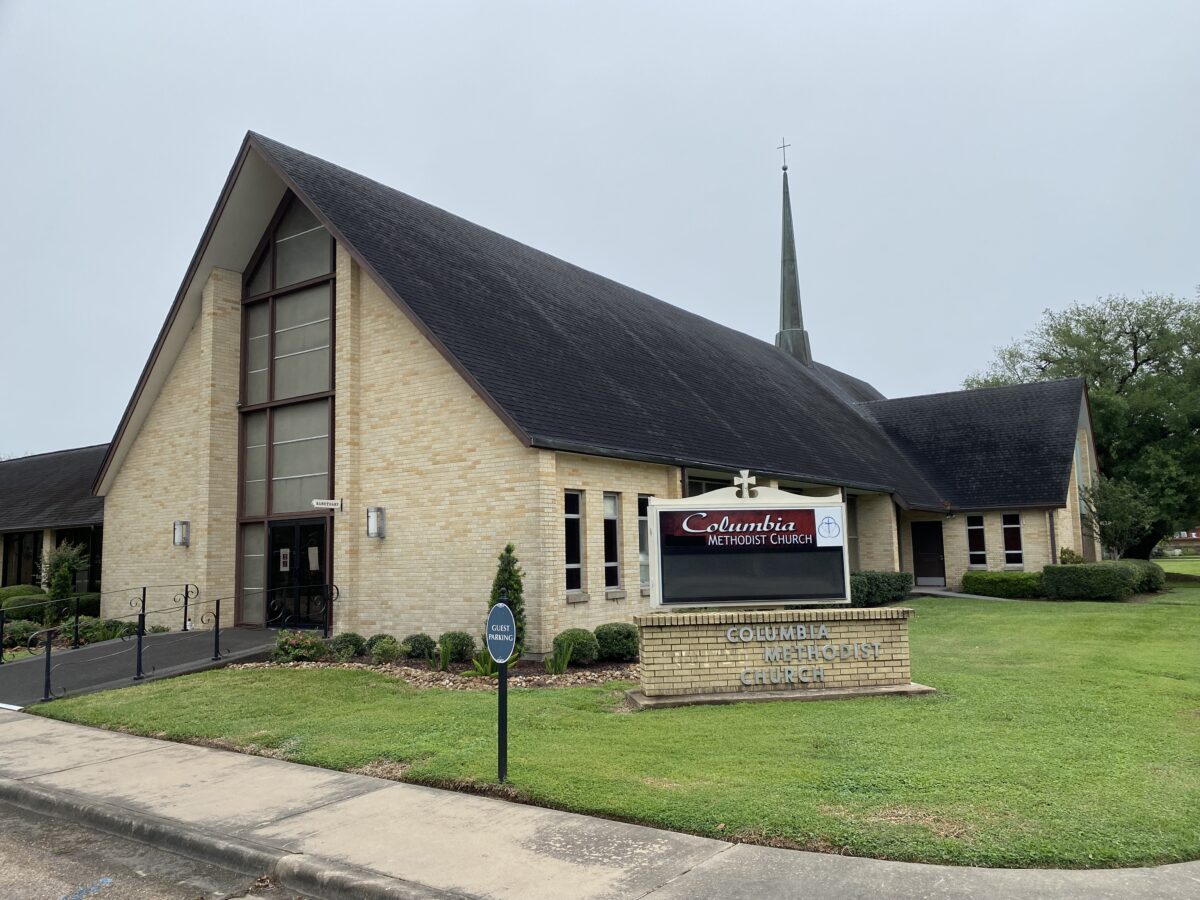
Columbia Methodist Church as it appears today has been holding weekly church services since 1958
At 2 p.m., re-interment services were held for the body of Rev. Isaac L.G. Strickland, who first organized the Methodist society in Columbia. His body now lies with his contemporaries of those historical years in the Columbia Cemetery, across from the church sanctuary.
In 1968, the Evangelical United Brethren and the Methodist Church merged to become The United Methodist Church.
Beginning in 1974, Howard Williams came as pastor, joining Donna Hankins as Secretary, Harold Rankin as organist, Ella Bacica as pianist and David Shepherd as choir director. Each family of the church made and contributed Chrismons for the annual Christmas tree beginning in 1976. Brenda Biever was youth director from 1976-1979 and the youth sang a song about each Chrismon which explained the meaning of each Chrismon. Dee Ann Brown (Ogburn) as a youth performed the narration. These Chrismons are still used every Christmas. There were strong adult, children and youth classes during the 1970s.
Pastor Glynn Ferguson came as pastor in 1977 and involved the church family with the community more than in the past. The choir director was David Farned and the church hired a youth director, Brad Crawford. A children’s choir and Kid’s Club combination on Thursdays was a real sensation with over 50 children attending regularly. The church purchased a van to transport the youth at that time and borrowed vans from the local Ford dealership in order to transport them. Volunteer drivers had to make several trips. ADC (Age Doesn’t Count) was formed by the seniors in the church who used the van to take field trips once a month. There were several church bazaars by the UMW every fall to raise money for missions. Under direction of Litha Crews, the courtyard was refurbished, planted and made useable for the congregation for church picnics and other festive occasions. The Episcopal, Presbyterian and Methodist congregations joined in community services for Ash Wednesday, Thanksgiving and Palm Sunday on a regular basis.
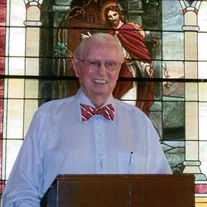
Rev. Charles Wilbur Danheim (1928-2021)
The 1980s saw the membership grow to 594, including inactive members. Rev. Charles Danheim was pastor. His love for music was apparent, and the church built strong adult and youth choirs directed by David Farned. The Christmas seasons were enhanced with live nativity scenes outside on the church lawn. There were seven children in the confirmation class in 1986. Brenda Biever began a children’s choir in 1987 which continued for 10 years. The choir was so popular that it divided into two and had 88 children in their last program. By the late 1980s the church membership had increased to 650 members. Rev. Fred T. Lang was the pastor and Paula Raeke was the choir director. Many children attended Sunday School and the nursery was filled every Sunday.
The church celebrated its 150th year with a six-month celebration from April to October. Former pastors Charles Danheim, Jim Neff, Howard Williams, Glynn Ferguson and Bishop Oliphint observed the generations of the church from 1839-1989. Brenda Biever became choir director. A group of women called “Flame Stitchers” began working on the kneeling cushion covers with needlepoint patterns. These were completed by the celebration in October 1989. Special gifts to the church during this event were the Rose Window behind the choir loft, the Plaque of Ministers, the brick Marque Sign on the corner, and the 1989 Methodist hymnals. The Boy Scouts were very active in the church during this decade. Evelyn Welsch drew and designed a special coloring book for the children about the 150 years of Columbia Methodists.
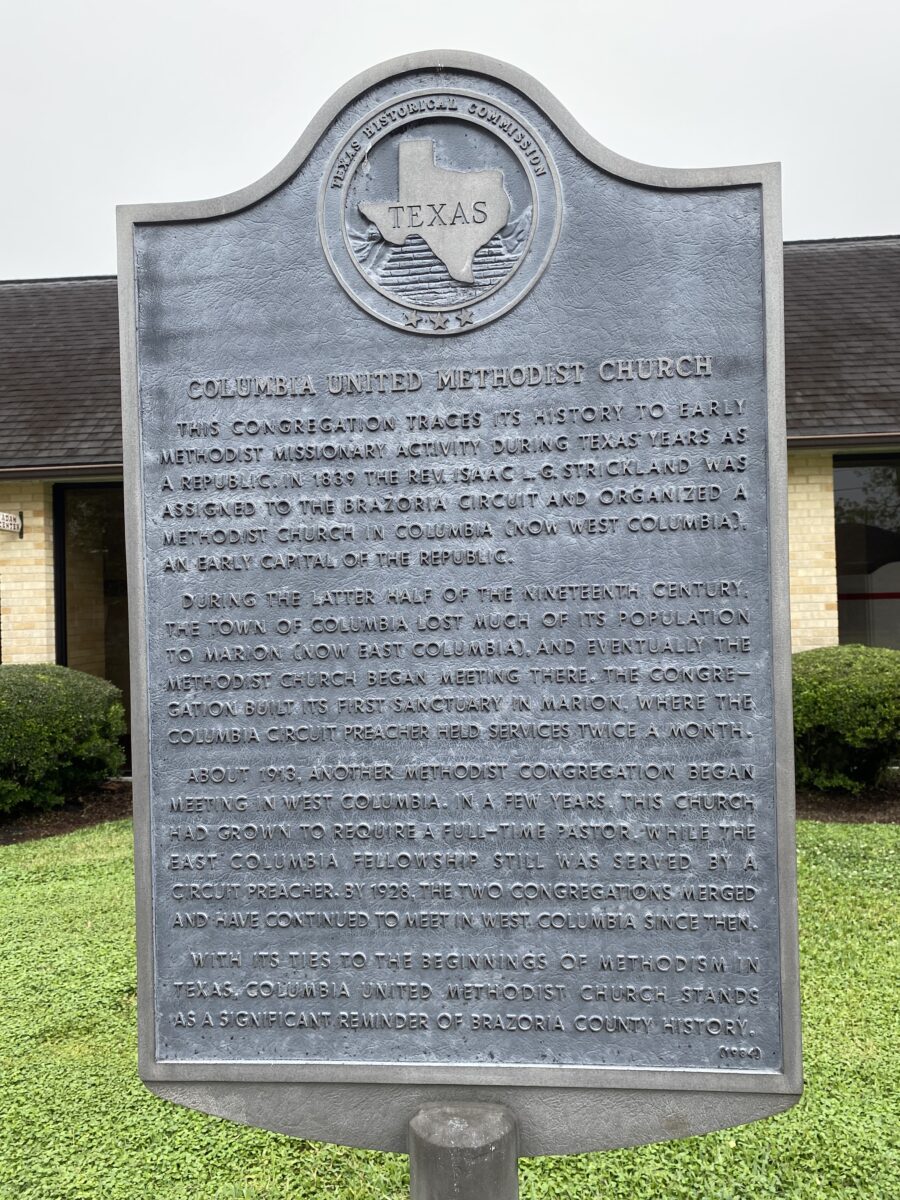
One of the important events for the church was the state historic marker being placed at the church in 1984 by the Texas Historic Landmark Commission. It reads as follows:
COLUMBIA UNITED METHODIST CHURCH
Recorded Texas Historic Landmark – 1984
This congregation traces its history to early Methodist Missionary activity during Texas’ years as a republic. In 1839 the Rev. Isaac L.G. Strickland was assigned to the Brazoria Circuit and organized a Methodist Church in Columbia (now West Columbia), an early capital of the republic.
During the latter half of the nineteenth century, the town of Columbia lost much of its population to Marion (now East Columbia), and eventually the Methodist Church began meeting there. The congregation built its first sanctuary in Marion, where the Columbia Circuit preacher held services twice a month.
About 1913, another Methodist congregation began meeting in West Columbia. In a few years, this church had grown to require a full-time pastor, while the East Columbia fellowship still was served by a circuit preacher. By 1928, the two congregations merged and have continued to meet in West Columbia since then.
With its ties to the beginnings of Methodism in Texas, Columbia United Methodist Church stands as a significant reminder of Brazoria County History.
By 1990 the church began using computers in the offices. A Social Concerns Committee was formed to visit shut-ins and form a food pantry. An early morning Food & Fellowship was begun with meetings in the church kitchen to enjoy a light breakfast before Sunday School. Rev. Ken Calhoun and his family came in 1991. It had been a long time since there were children in the parsonage, so there were many improvements to make in order for the house to be ready and the yard “kid-proofed” for them. Kathy Hathway was youth minister in 1992 until August 1994 and Janet Humphrey was pianist. In late 1994, Fawn Mikel became youth minister.
The beautiful stained glass windows along the walls of the sanctuary were dedicated on May 31, 1992. The north and south-side windows portray the Birth, Baptism, Last Supper, Crucifixion, Resurrection and Pentecost. At the side doors are the Cross & Flames, Open Bible, the Cross & Crown, and Palm Branches. There was a complete refurbishing of the church. Vacation Bible School became an evening event with an outdoor market venue. The Disciples Study I and II were offered to the congregation.
Rev. Rex Carlton came as the pastor in 1998 to find a general movement to build a larger fellowship hall. The finance committee began working to earn and save and plan for the addition that would begin in 2002. The MYF was saluted many times over as outstanding with UMArmy and summer camp being the highlight year after year. In 2002, Patsy Averitt became secretary and Sue Salter was program director. The children of the church, no matter their age, were involved in many activities including Kid’s Club, choir, study classed, Scouts, UMArmy and Vacation Bible School.
A large fellowship hall, kitchen and offices were dedicated in June 2003 and are a benefit for the whole church and community.
The whole decade found the church involved with help for the community as outreach missions in many forms. There was a Columbia High School Bible Study every Wednesday. Several youth ministers in the community held Bible study at CHS for those who wanted to participate. The MYF was very active and worked during the summer helping older church members with cleaning yards and other service projects. Many attended summer church camp. Kid’s Club continued every Wednesday after school.
A new program called “Feed My Lambs” was established during 2003 and still continues every summer. The children who need a lunch in the community are provided a drink, sack lunch and coloring sheets of Christian stories every Monday, Wednesday and Friday during the summer school break. Many other churches in the community work with CUMC to provide the food, cooking, assembly and delivery of the lunches. The women of the church worked by holding rummage sales in the fellowship hall to raise money for projects. The food pantry continued to provide food for those families in the community who were in need. Our pastor, Greg Rogers was ably assisted by Church Administrator Patsy Averitt, Program Director Sue Salter, and Music Director and Organist Brenda Biever.
Pastor Patricia Wehn-Glowski was the first woman pastor for our church beginning in 2011. She provided the congregation with many opportunities for Bible study and service to the community. These programs flourished. Jenny Paul Kier became the program director and introduced the children and youth of the church to many new ideas for spiritual growth and understanding. Members of the church were involved with helping those returning from a hospital stay, experiencing long term illness, visiting in the nursing homes, providing food for the needy, and supporting community events and drives. In late 2013, Jenny Kier stepped aside to care for her family and Gaelynn Boone Brown stepped in to become program director. Also, that year, Choir/Music Director Brenda Biever took a well-deserved year’s hiatus after 25 years of service as music director.
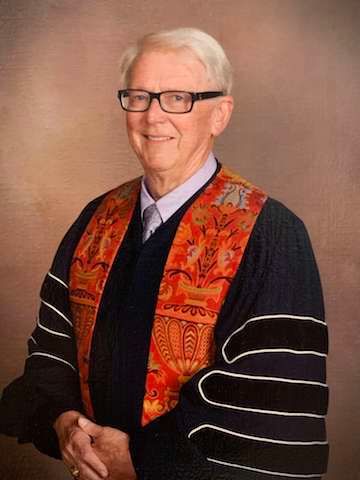
Dr. Michael Ross Deaton (1945-2020)
Beginning in 2014, Dr. Michael Deaton became pastor and immediately brought organization to the Sunday morning worship, staff and records. On July 20, 2014, a new, electronic sign installed by several men of the church was dedicated to show passersby that the church is a living, active church. Following, on March 1, 2015, the church celebrated its 175th anniversary as a Methodist congregation serving the West Columbia area. Bishop Janice Riggle Huie honored the West Columbia church by placing a wreath on Rev. Strickland’s monument and presiding over the Sunday morning worship service.
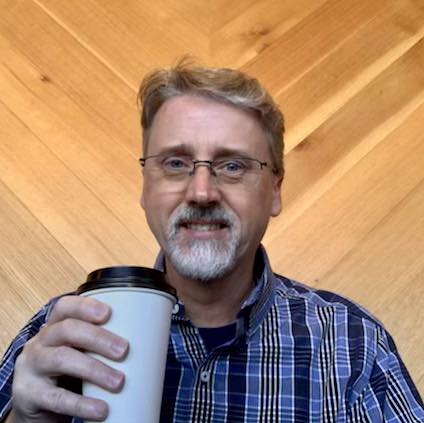
Rev. Dan Conway is the current pastor of Columbia Methodist Church
